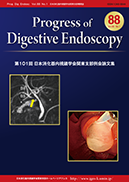Volume 88, Issue 1
Displaying 51-67 of 67 articles from this issue
Case report
-
2016Volume 88Issue 1 Pages 160-161
Published: June 11, 2016
Released on J-STAGE: July 01, 2016
Download PDF (905K) -
2016Volume 88Issue 1 Pages 162-163
Published: June 11, 2016
Released on J-STAGE: July 01, 2016
Download PDF (902K) -
2016Volume 88Issue 1 Pages 164-165
Published: June 11, 2016
Released on J-STAGE: July 01, 2016
Download PDF (1030K) -
2016Volume 88Issue 1 Pages 166-167
Published: June 11, 2016
Released on J-STAGE: July 01, 2016
Download PDF (785K) -
2016Volume 88Issue 1 Pages 168-169
Published: June 11, 2016
Released on J-STAGE: July 01, 2016
Download PDF (844K) -
2016Volume 88Issue 1 Pages 170-171
Published: June 11, 2016
Released on J-STAGE: July 01, 2016
Download PDF (1071K) -
2016Volume 88Issue 1 Pages 172-173
Published: June 11, 2016
Released on J-STAGE: July 01, 2016
Download PDF (742K) -
2016Volume 88Issue 1 Pages 174-175
Published: June 11, 2016
Released on J-STAGE: July 01, 2016
Download PDF (1028K) -
2016Volume 88Issue 1 Pages 176-177
Published: June 11, 2016
Released on J-STAGE: July 01, 2016
Download PDF (827K) -
2016Volume 88Issue 1 Pages 178-179
Published: June 11, 2016
Released on J-STAGE: July 01, 2016
Download PDF (798K) -
2016Volume 88Issue 1 Pages 180-181
Published: June 11, 2016
Released on J-STAGE: July 01, 2016
Download PDF (894K) -
2016Volume 88Issue 1 Pages 182-183
Published: June 11, 2016
Released on J-STAGE: July 01, 2016
Download PDF (789K) -
2016Volume 88Issue 1 Pages 184-185
Published: June 11, 2016
Released on J-STAGE: July 01, 2016
Download PDF (964K) -
2016Volume 88Issue 1 Pages 186-187
Published: June 11, 2016
Released on J-STAGE: July 01, 2016
Download PDF (1000K) -
2016Volume 88Issue 1 Pages 188-189
Published: June 11, 2016
Released on J-STAGE: July 01, 2016
Download PDF (821K) -
2016Volume 88Issue 1 Pages 190-191
Published: June 11, 2016
Released on J-STAGE: July 01, 2016
Download PDF (653K) -
2016Volume 88Issue 1 Pages 192-193
Published: June 11, 2016
Released on J-STAGE: July 01, 2016
Download PDF (913K)













